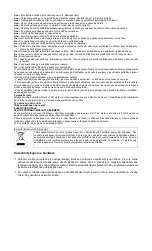
recommended by the manufacturer.
D
o not store explosive substances such as aerosol cans with a flammable propellant in this appliance.
T
his appliance is not intended for use by persons (including children) with reduced physical, sensory or mental capabilities,
or lack of experience and knowledge, unless they have been given supervision or instruction concerning use of the appliance
by a person responsible for their safety. Children should be supervised to ensure that they do not play with the appliance.
–
WARNING:
Keep ventilation openings, in the appliance enclosure or in the built-in structure, clear of
obstruction.
–
WARNING:
Do not use mechanical devices or other means to accelerate the defrosting process, other than
those recommended by the manufacturer.
–
WARNING:
Do not damage the refrigerant circuit.
–
WARNING:
Do not use electrical appliances inside the food storage compartments of the appliance, unless
they are of the type recommended by the manufacturer.
–
WARNING:
Refrigerating appliances – in particular a refrigerator-freezer Type I – might not operate
consistently (possibility of defrosting of contents or temperature becoming too warm in the frozen food compartment) when
sited for an extended period of time below the cold end of the range of temperatures for which the refrigerating appliance is
designed;
–
WARNING:
The necessity that, for doors or lids fitted with locks and keys, the keys be kept out of the reach of
children and not in the vicinity of the refrigerating appliance, in order to prevent children from being locked inside.
–
WARNING:
The refrigerant used in your appliance and insulation materials requires special disposal
procedures.
–
WARNING:
When positioning the appliance, ensure the supply cord is not trapped or damaged.
–
WARNING:
Do not locate multiple portable socket-outlets or portable power supplies at the rear of the
appliance
Children aged from 3 to 8 years are allowed to load and unload refrigerating appliances. To avoid contamination of food,
please respect the following instructions:
– Opening the door for long periods can cause a significant increase of the temperature in the compartments of the
appliance.
–Clean regularly surfaces that can come in contact with food and accessible drainage systems.
–Clean water tanks if they have not been used for 48 h; flush the water system connected to a water supply if water has
not been drawn for 5 days.
– Store raw meat and fish in suitable containers in the refrigerator, so that it is not in contact with or drip onto other food.
– Two-star frozen-food compartments are suitable for storing pre-frozen food, storing or making ice-cream and making ice
cubes.
– One-, two- and three-star compartments are not suitable for the freezing of fresh food.
–If the refrigerating appliance is left empty for long periods, switch off, defrost, clean, dry, and leave the door open to
prevent mould developing within the appliance.
Climate Range
The information about the climate range of the appliance is provided on the rating plate. It indicates at which ambient
temperature (that is, room temperature, in which the appliance is working) the operation of the appliance is optimal (proper).
Climate range
Permissible ambient temperature
SN
from +10°C to +32°C
N
from +16°C to +32°C
ST
from +16°C to +38°C
T
from +16°C to +43°C
Note
:
Given the limit values of the ambient temperature range for the climate classes for which the refrigerating appliance is
designed and the fact that the internal temperatures could be affected by such factors as location of the refrigerating
appliance, ambient temperature and the frequency of door opening, the setting of any temperature control device might have
to be varied to allow for these factors, if appropriate.
If the power cable is damaged, it must be replaced by the manufacturer, its service agent or similarly qualified persons in
order to avoid a hazard.
Note:
When operating in an environment other than the specified climate type (i.e., beyond the rated ambient temperature
range), the appliance may not be able to maintain the desirable compartment temperatures.
Locks
If your Refrigerator is fitted with a lock, keep the key out of reach and not in the vicinity of the appliance to prevent children
Summary of Contents for CMCH 100 D
Page 1: ...CHEST FREEZER INSTRUCTION MANUAL MODEL NO CMCH 200 D CMCH 100 D CMCH 150 D ...
Page 10: ...TRUHLICOVÝ MRAZÁK NÁVOD K OBSLUZE Č MODELU CMCH 200 D CMCH 100 D CMCH 150 D ...
Page 19: ...KÜHLTRUHE BEDIENUNGSHANDBUCH MODEL NR CMCH 200 D CMCH 100 D CMCH 150 D ...
Page 37: ...CONGELADOR HORIZONTAL MANUAL DE INSTRUCCIONES N º DE MODELO CMCH 200 D CMCH 100 D CMCH 150 D ...
Page 46: ...CONGÉLATEUR COFFRE MANUEL D INSTRUCTIONS MODÈLE N CMCH 200 D CMCH 100 D CMCH 150 D ...
Page 55: ...ZAMRZIVAČ ŠKRINJA PRIRUČNIK S UPUTAMA BR MODELA CMCH 200 D CMCH 100 D CMCH 150 D ...
Page 64: ...CONGELATORE VERTICALE MANUALE DI ISTRUZIONI MODELLO N CMCH 200 D CMCH 100 D CMCH 150 D ...
Page 73: ...ZAMRAŻARKA SKRZYNIOWA INSTRUKCJA OBSŁUGI NR MODELU CMCH 200 D CMCH 100 D CMCH 150 D ...
Page 82: ...ARCA CONGELADORA MANUAL DE INSTRUÇÕES N º DE MODELO CMCH 200 D CMCH 100 D CMCH 150 D ...
Page 91: ...LADĂ FRIGORIFICĂ MANUAL DE UTILIZARE NUMĂRUL MODELULUI CMCH 200 D CMCH 100 D CMCH 150 D ...
Page 100: ...ZAMRZOVALNA SKRINJA NAVODILA ZA UPORABO ŠT MODELA CMCH 200 D CMCH 100 D CMCH 150 D ...
Page 109: ...HORIZONTALNI ZAMRZIVAČ UPUTSTVO ZA UPOTREBU BR MODELA CMCH 200 D CMCH 100 D CMCH 150 D ...




































